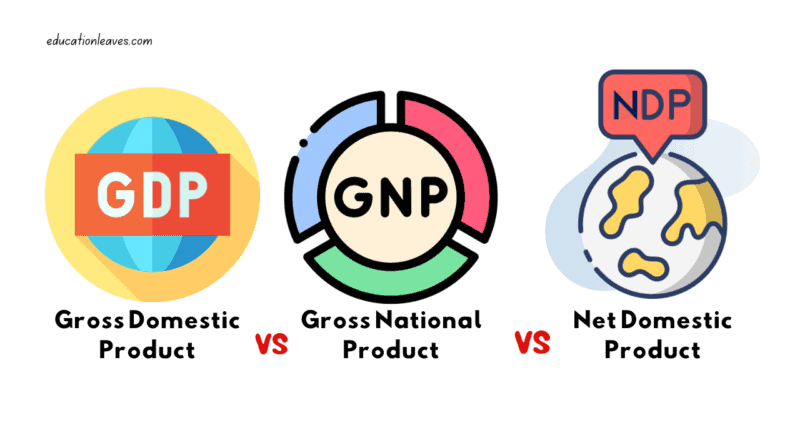What are GDP, GNP, and NDP? Comparison Between Them.
Gross Domestic Product (GDP), Gross National Product (GNP), and Net Domestic Product (NDP) are key economic indicators that play pivotal roles in assessing a country’s economic performance. GDP represents the total value of all goods and services produced within a nation’s borders over a specific time period, serving as a comprehensive measure of a country’s economic health.
GNP, on the other hand, goes beyond domestic boundaries, encompassing the total output produced by a country’s residents, regardless of their location, and includes income earned abroad. This metric reflects the economic strength of a country’s citizens globally.
In contrast, NDP adjusts GDP by accounting for depreciation, providing a more nuanced perspective on a nation’s economic output by considering the wear and tear on capital goods. Each of these metrics serves distinct purposes, with GDP focusing on internal economic activity, GNP providing a global perspective, and NDP offering insights into the net domestic economic product after factoring in capital depreciation. Together, these indicators contribute to a comprehensive understanding of a nation’s economic landscape, aiding policymakers, analysts, and businesses in making informed decisions.
What you are going to learn?
Gross Domestic Product (GDP)

Gross Domestic Product (GDP) is a key economic indicator that represents the total value of all goods and services produced within a country’s borders over a specific period of time. It is a comprehensive measure that provides insight into the overall health and size of an economy.
Here are the key components and aspects to help you understand the concept of GDP:
- Definition and Calculation:
GDP is calculated by adding up the value of all final goods and services produced in a country during a specific time period. There are three primary approaches to measuring GDP:
- Production or Output Approach: Calculates GDP by summing the value of all goods and services produced in various sectors of the economy.
- Income Approach: Calculates GDP by adding up all incomes earned by individuals and businesses, including wages, profits, and taxes.
- Expenditure Approach: Calculates GDP by summing up all expenditures made on final goods and services, including consumption, investment, government spending, and net exports (exports minus imports).
- Components of GDP:
- Consumption (C): The total value of goods and services consumed by households.
- Investment (I): Includes spending on business capital, residential construction, and changes in business inventories.
- Government Spending (G): The total expenditures by the government on goods and services.
- Net Exports (Exports – Imports): The value of a country’s exports minus its imports.
- Types of GDP:
- Nominal GDP: The total value of goods and services produced in current prices without adjusting for inflation or deflation.
- Real GDP: Adjusts nominal GDP for changes in price levels, providing a more accurate measure of economic growth.
- Significance:
- GDP is a critical indicator of a country’s economic performance and is often used to compare the economic health of different nations.
- It helps policymakers, investors, and businesses make informed decisions by providing insights into the overall economic activity.
- Limitations:
- GDP does not account for income distribution, so a high GDP does not necessarily mean equitable wealth distribution.
- It does not consider informal or underground economic activities.
- Quality of life indicators, environmental sustainability, and other non-economic factors are not reflected in GDP.
Gross National Product (GNP)

Gross National Product (GNP) is an economic metric that represents the total market value of all final goods and services produced by the residents of a country, including both domestic and foreign production, within a specific time period. GNP provides a broader perspective on a country’s economic performance by taking into account the production activities of its citizens, regardless of whether they occur within the country’s borders or abroad.
Here are the key components and aspects to help you understand the concept of GNP:
- Definition and Calculation:
- GNP is calculated by adding the Gross Domestic Product (GDP) of a country to the income earned by its residents from abroad, minus the income earned by foreign residents within the country’s borders.
- Components of GNP:
- Gross Domestic Product (GDP): Represents the total value of all goods and services produced within the country’s borders.
- Net Foreign Factor Income (NFFI): Includes the net income earned from abroad by the country’s residents and businesses, minus the income earned by foreign residents and businesses within the country.
- Formula: GNP=GDP+NFFI
- Significance:
- GNP provides a more comprehensive measure of a country’s economic performance by including the earnings of its residents from foreign economic activities.
- It reflects the contribution of a country’s citizens to the global economy.
- Comparison with GDP:
- If a country’s GNP is higher than its GDP, it indicates that the country’s residents are earning more from their economic activities abroad than foreign residents are earning within the country. Conversely, if GNP is lower than GDP, it suggests that foreign residents are earning more within the country than the country’s residents are earning abroad.
- Limitations:
- GNP, like GDP, has limitations such as not accounting for income distribution, informal economic activities, and non-economic factors like environmental sustainability.
- It may not fully capture the economic well-being of a nation, as it focuses primarily on monetary transactions.
Net Domestic Product (NDP)

Net Domestic Product (NDP) is an economic indicator that represents the total market value of all final goods and services produced within a country’s borders, minus the depreciation of its capital assets over a specific period. In essence, NDP provides a measure of the net output generated by an economy after accounting for the wear and tear on its capital stock.
Here are the key components and aspects to help you understand the concept of Net Domestic Product:
- Definition and Calculation:
- NDP is calculated by subtracting the depreciation (or capital consumption allowance) from the Gross Domestic Product (GDP) of a country. Depreciation accounts for the reduction in the value of capital goods, such as machinery and buildings, due to factors like wear and tear over time.
- Importance of Depreciation:
- Depreciation is a crucial factor in assessing the sustainability of economic growth. If an economy is producing a significant amount of output but also experiencing high levels of depreciation, the net gain in wealth and well-being may be lower than suggested by GDP alone.
- Net Investment:
- NDP provides insights into the net investment in an economy. If NDP is positive, it indicates that the economy is investing enough to replace depreciated capital, contributing to the maintenance and growth of its productive capacity.
- Comparison with GDP:
- GDP measures the total output of an economy without considering the depreciation of capital. NDP, on the other hand, adjusts for this depreciation, providing a more accurate reflection of the sustainable economic output.
- Significance:
- NDP is useful for policymakers and economists as it helps gauge the actual economic well-being of a nation by considering the long-term sustainability of its economic growth.
- It offers a more realistic assessment of the economic output available for consumption and future investment.
- Limitations:
- Similar to GDP, NDP has limitations, such as not accounting for non-market activities, income distribution, and environmental factors.
- It may not fully capture the overall economic health or societal welfare of a nation.
In summary, Net Domestic Product is a measure of the net economic output of a country, accounting for the depreciation of its capital assets. It provides a more realistic perspective on the sustainability of economic growth and the available resources for consumption and investment.
Comparison Table Between GDP, GNP, and NDP
Certainly! Let’s add a few more rows to further enhance the comparison:
| Criteria | Gross Domestic Product (GDP) | Net Domestic Product (NDP) | Gross National Product (GNP) |
|---|---|---|---|
| Definition | The total value of all goods and services produced within the borders of a country in a specific time period. | Similar to GDP, but it accounts for depreciation and capital consumption. NDP is derived by subtracting depreciation from GDP. | The total value of all goods and services produced by a country’s residents, including those living abroad, within a specific time period. |
| Exclusions | Excludes income earned by foreign residents within the country’s borders. | Excludes depreciation and capital consumption. | Includes income earned by the country’s residents abroad, minus income earned by foreign residents within the country. |
| Formula | GDP = Consumption + Investment + Government Spending + (Exports – Imports) | NDP = GDP – Depreciation | GNP = GDP + (Net income earned from abroad) |
| Purpose | Measures the economic performance and health of a country. | Provides a more accurate representation of a country’s economic output by factoring in depreciation. | Reflects the economic strength of a country’s residents, whether they are within the country or abroad. |
| Focus | Primarily focuses on the economic activity within a country’s borders. | Emphasizes the net value produced within the country by considering depreciation. | Takes into account the overall economic well-being of a country’s residents, regardless of their location. |
| Depreciation Adjustment | Does not account for depreciation. | Accounts for depreciation by subtracting it from GDP. | Does not account for depreciation explicitly; it’s more concerned with the location of economic activity. |
| International Perspective | Does not consider the earnings of residents working abroad. | Limited international perspective, as it focuses on the net value within the country. | Incorporates income earned by the country’s residents globally. |
| Economic Welfare | May not fully represent the well-being of citizens if income inequality is significant. | Offers a more accurate measure of the economic well-being of citizens by considering the impact of depreciation on capital stock. | Reflects the overall economic welfare of a country’s residents, including those living abroad. |
| External Debt Impact | Does not directly account for the impact of external debt on the economy. | External debt can impact NDP if it affects the depreciation rate. | Can be influenced by external debt, as it considers the income earned abroad. |
| Sustainability | Does not explicitly consider the sustainability of economic growth. | Reflects a more sustainable measure by accounting for the depreciation of capital. | May be influenced by the sustainability of income generated from both domestic and foreign sources. |
| Comparison Challenges | May lead to misleading conclusions if not considered alongside other metrics. | Provides a clearer picture but may not capture all external economic factors. | Requires consideration of various factors such as exchange rates and global economic conditions for accurate comparison. |
Expanding the comparison with these additional rows provides a more comprehensive understanding of the nuances between GDP, NDP, and GNP, including their implications for economic welfare, sustainability, and the impact of external factors like debt.




